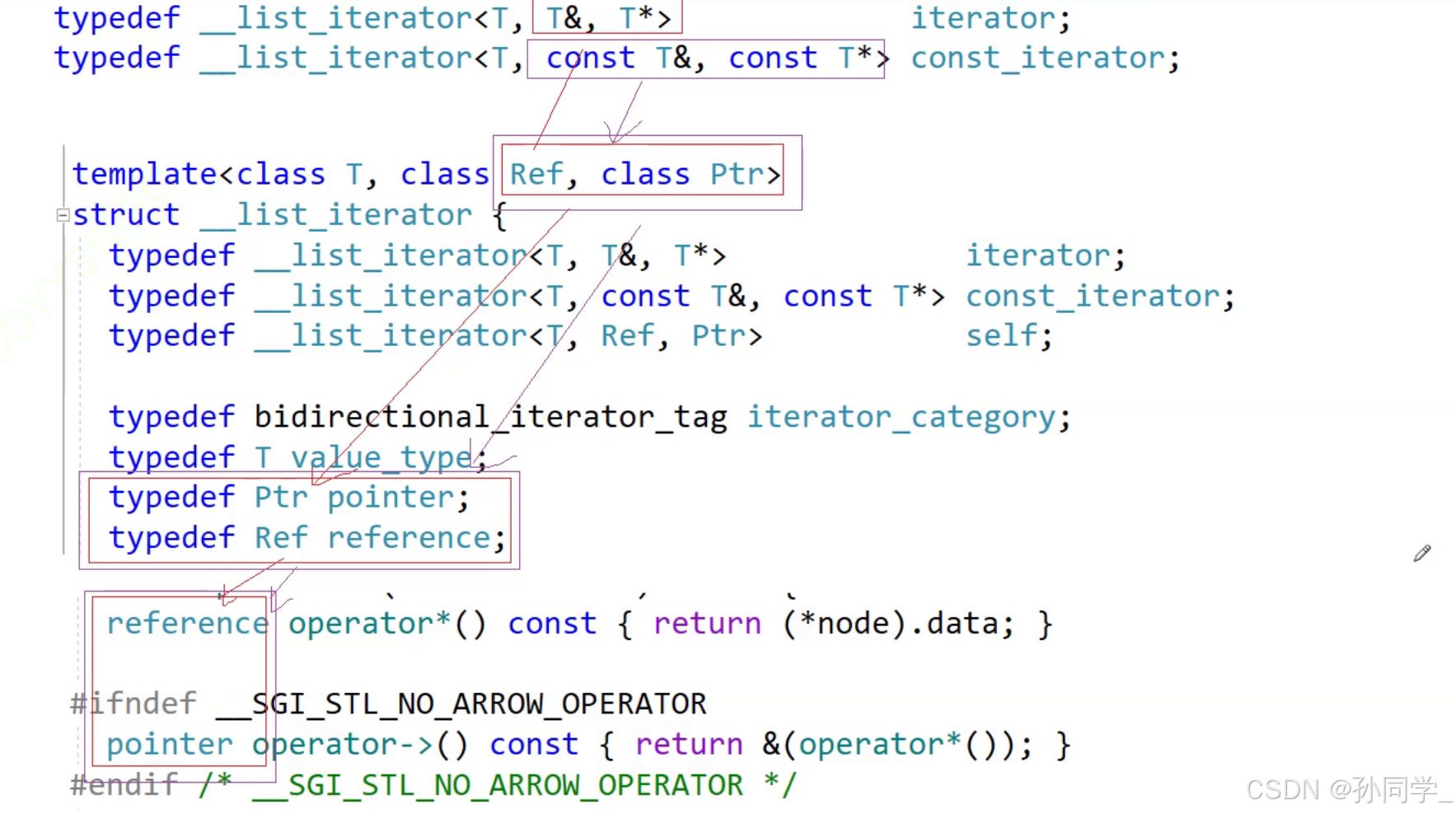
文章目錄
- 前言:
- 一.list的介紹及使用
- 1. list的介紹
- 2. list的使用
- 2.1 list的構造
- 2.2 list iterator的使用
- 2.3 list capacity
- 2.4 list element access
- 2.5 list modi?ers
- 2.6 list的迭代器失效
- 二.list的模擬實現
- 1. list的節點
- 2. list的成員變量
- 3.list迭代器相關問題
- 3.1 普通迭代器
- 3.2 const迭代器
- 4. list的成員函數
- 4.1 list的空初始化
- 4.2 push_back
- 4.3 構造函數
- 4.4 insert
- 4.4 erase
- 4.5 push_front
- 4.6 pop_front
- 4.7 pop_back
- 4.8 clear
- 4.8 析構函數
- 4.9 swap
- 4.10 賦值運算符重載
- 最后想說:
前言:
?C++中的List容器是標準模板庫(STL)中的一種序列容器,它實現了雙向鏈表的功能。與數組(如vector)和單向鏈表相比,List容器提供了更加靈活的元素插入和刪除操作,特別是在容器中間位置進行這些操作時。
一.list的介紹及使用
1. list的介紹
- 雙向鏈表結構: list容器使用雙向鏈表來存儲元素,每個元素(節點)都包含數據部分和兩個指針,分別指向前一個元素和后一個元素。這種結構使得在鏈表的任何位置進行插入和刪除操作都非常高效,時間復雜度為
O(1)。 - 動態大小: list容器的大小可以在運行時動態改變,即可以在程序運行過程中添加或移除元素。
- 不支持隨機訪問: 與
vector和array等連續內存的容器不同,list不支持隨機訪問迭代器,不能直接通過索引獲取元素,而需要通過迭代器遍歷。 - 迭代器穩定性: 在list中插入或刪除元素不會導致其他迭代器失效(除了指向被刪除元素的迭代器)。這是因為它通過調整相鄰節點的指針來維護鏈表結構,而不需要移動元素或重新分配內存。
2. list的使用
list的使用參考文檔:list的文檔介紹

2.1 list的構造
| 構造函數 | 接口說明 |
|---|---|
| list (size_type n, const value_type& val =value_type() ) | 構造的list中包含n個值為val的元素 |
| list() | 構造空的list |
| list (const list& x) | 拷貝構造函數 |
| list (InputIterator ?rst, InputIterator last) | 用[?rst, last)區間中的元素構造list |
代碼演示:
#include<list>
int main()
{list<int> l1;//構造空的l1;list<int> l2(4,100);//l2中存放4個值為100的元素list<int> l3(l2.begin(),l2.end());//用l2的[begin,end)左開右閉區間構造l3;list<int> l4(l3);//用l3拷貝構造l4// 以數組為迭代器區間構造l5int array[] = { 16,2,77,29 };list<int> l5(array, array + sizeof(array) / sizeof(int));// 列表格式初始化C++11list<int> l6{ 1,2,3,4,5 };// 用迭代器方式打印l5中的元素list<int>::iterator it = l5.begin();while (it != l5.end()){cout << *it << " ";++it;}cout << endl;// C++11范圍for的方式遍歷for (auto& e : l5)cout << e << " ";cout << endl;return 0;
}
2.2 list iterator的使用
此處,大家可暫時將迭代器理解成一個指針,該指針指向list中的某個節點。
| 函數聲明 | 接口說明 |
|---|---|
| begin | 返回第一個元素的迭代器 |
| end | 返回最后一個元素下一個位置的迭代器 |
| rbegin | 返回一個指向容器中最后一個元素的反向迭代器(即容器的反向起始) |
| rend | 返回一個反向迭代器,該迭代器指向列表容器中第一個元素之前的理論元素(該元素被認為是其反向結束)。 |
注意:
- begin與end為正向迭代器,對迭代器執行++操作,迭代器向后移動
- rbegin(end)與rend(begin)為反向迭代器,對迭代器執行++操作,迭代器向前移動
代碼演示:
int main()
{int array[] = { 1, 2, 3, 4, 5, 6, 7, 8, 9, 0 };list<int> l(array, array + sizeof(array) / sizeof(array[0]));// 使用正向迭代器正向list中的元素// list<int>::iterator it = l.begin(); // C++98中語法auto it = l.begin(); // C++11之后推薦寫法while (it != l.end()){cout << *it << " ";++it;}cout << endl;// 使用反向迭代器逆向打印list中的元素// list<int>::reverse_iterator rit = l.rbegin();auto rit = l.rbegin();while (rit != l.rend()){cout << *rit << " ";++rit;}cout << endl;return 0;
}
2.3 list capacity
| 函數聲明 | 接口說明 |
|---|---|
| front | 檢測list是否為空,是返回true,否則返回false |
| size | 返回list中有效節點的個數 |
2.4 list element access
| 函數聲明 | 接口說明 |
|---|---|
| front | 返回list的第一個節點中值的引用 |
| back | 返回list的最后一個節點中值的引用 |
2.5 list modi?ers
| 函數聲明 | 接口說明 |
|---|---|
| push_front | 在list首元素前插入值為val的元素 |
| pop_front | 刪除list中第一個元素 |
| push_back | 在list尾部插入值為val的元素 |
| pop_back | 刪除list中最后一個元素 |
| insert | 在list position 位置中插入值為val的元素 |
| erase | 刪除list position位置的元素 |
| swap | 交換兩個list中的元素 |
| clear | 清空list中的有效元素 |
代碼演示:
#include<iostream>
#include<vector>
using namespace std;void PrintList(const list<int>& l)
{// 注意這里調用的是list的 begin() const,返回list的const_iterator對象for (list<int>::const_iterator it = l.begin(); it != l.end(); ++it){cout << *it << " ";}cout << endl;
}// list插入和刪除
// push_back/pop_back/push_front/pop_front
void TestList1()
{int array[] = { 1, 2, 3 };list<int> L(array, array + sizeof(array) / sizeof(array[0]));// 在list的尾部插入4,頭部插入0L.push_back(4);L.push_front(0);PrintList(L);// 刪除list尾部節點和頭部節點L.pop_back();L.pop_front();PrintList(L);
}// insert /erase
void TestList2()
{int array1[] = { 1, 2, 3 };list<int> L(array1, array1 + sizeof(array1) / sizeof(array1[0]));// 獲取鏈表中第二個節點auto pos = ++L.begin();cout << *pos << endl;// 在pos前插入值為4的元素L.insert(pos, 4);PrintList(L);// 在pos前插入5個值為5的元素L.insert(pos, 5, 5);PrintList(L);// 在pos前插入[v.begin(), v.end)區間中的元素vector<int> v{ 7, 8, 9 };L.insert(pos, v.begin(), v.end());PrintList(L);// 刪除pos位置上的元素L.erase(pos);PrintList(L);// 刪除list中[begin, end)區間中的元素,即刪除list中的所有元素L.erase(L.begin(), L.end());PrintList(L);
}// resize/swap/clear
void TestList3()
{// 用數組來構造listint array1[] = { 1, 2, 3 };list<int> l1(array1, array1 + sizeof(array1) / sizeof(array1[0]));PrintList(l1);// 交換l1和l2中的元素list<int> l2;l1.swap(l2);PrintList(l1);PrintList(l2);// 將l2中的元素清空l2.clear();cout << l2.size() << endl;
}int main()
{TestList1();TestList2();TestList3();return 0;
}
運行結果:

2.6 list的迭代器失效
?前面已經說過了,此處可以將迭代器理解為類似于指針的東西,迭代器失效即迭代器指向的節點失效了,即該節點被刪除了。因為list的底層結構為帶頭結點的雙向循環鏈表,因此在list進行插入操作時不會導致迭代器失效,只有刪除時才會失效,并且失效的是被刪除節點的迭代器,其他迭代器不會受到影響。
二.list的模擬實現
1. list的節點
template<class T>
struct list_node
{T _data;list_node<T>* _next;list_node<T>* _prev;list_node(const T& x = T()):_data(x), _next(nullptr), _prev(nullptr){}
};
2. list的成員變量
template<class T>
class list
{typedef list_node<T> Node;
public://成員函數
private:Node* _head; //哨兵位的頭節點
};
?沒有用訪問限定符限制的成員class默認是私有的,struct默認是公有的,如果一個類既有公有也有私有就用class,全部為公有一般用struct。這不是規定,只是個慣例。
3.list迭代器相關問題
簡單分析:
&emsp; 這里不能像以前一樣給一個結點的指針作為迭代器,如果it是typedef的節點的指針,it解引用得到的是節點,不是里面的數據,但是我們期望it解引用是里面的數據,++it我們期望走到下一個節點去,而list中++走不到下一個數據,因為數組的空間是連續的,++可以走到下一個數據。但是鏈表達不到這樣的目的。所以原身指針已經無法滿足這樣的行為,怎么辦呢?這時候我們的類就登場了
?用類封裝一下節點的指針,然后重載運算符,模擬指針。
例如:
reference operator*()const
{return (*node).data;
}
self& opertor++()
{node = (link_type)((*node).next);return *this;
}
3.1 普通迭代器
template<class T>
struct list_iterator
{typedef list_node<T> Node;typedef list_iterator<T> Self;Node* _node;list_iterator(Node* node):_node(node){}T& operator*() //用引用返回可以讀數據也可以修改數據{return _node->_data;}T* operator->(){return &_node->_data;}Self& operator++(){_node = _node->_next;return *this;}Self& operator--(){_node = _node->_prev;return *this;}Self operator++(int){Self tmp(*this);_node = _node->_next;return tmp;}Self operator--(int){Self tmp(*this);_node = _node->_prev;return tmp;}bool operator!=(const Self& s){return _node != s._node;}
};
3.2 const迭代器
const迭代器在定義的時候不能直接定義成typedef const list_iterator<T> const_iterator,const迭代器的本質是限制迭代器指向的內容不能被修改,而前面的這種寫法限制了迭代器本身不能被修改,所以迭代器就不能進行++操作。那該怎能辦呢?答案是我們可以實現一個單獨的類:
template<class T>
struct list_const_iterator
{typedef list_node<T> Node;typedef list_const_iterator<T> Self;Node* _node;list_const_iterator(Node* node):_node(node){}const T& operator*(){return _node->_data; //返回這個數據的別名,但是是const別名,所以不能被修改}const T* operator->(){return &_node->_data; //我是你的指針,const指針}Self& operator++(){_node = _node->_next;return *this;}Self& operator--(){_node = _node->_prev;return *this;}Self operator++(int){Self tmp(*this);_node = _node->_next;return tmp;}Self operator--(int){Self tmp(*this);_node = _node->_prev;return tmp;}bool operator!=(const Self& s){return _node != s._node;}
};
普通法迭代器與const迭代器的區別就是:普通迭代器可讀可寫,const迭代器只能讀
上面是我們自己實現的普通迭代器和const迭代器,用兩個類,并且這兩個類高度相似,下來就讓我們一起看一看庫里面是怎么實現的吧!

我們可以看到庫里面是寫了兩個模板,讓編譯器去生成對應的類。其本質上也是寫了兩個類,只不過是讓編譯器去生成對應的類。
迭代器不需要我們自己寫析構函數、拷貝構造函數、賦值運算符重載函數,因為這里要的是淺拷貝,例如我把一個迭代器賦值給另外一個迭代器,就是期望兩個迭代器指向同一個節點,這里用淺拷貝即可,拷貝給你我們兩個迭代器就指向同一個節點。
4. list的成員函數
4.1 list的空初始化
void empty_init() //空初始化
{_head = new Node();_head->_next = _head;_head->_prev = _head;
}
4.2 push_back
//普通版本
void push_back(const T& x)
{Node* new_node = new Node(x);Node* tail = _head->_prev;tail->_next = new_node;new_node->_prev = tail;new_node->_next = _head;_head->_prev = new_node;
}
//復用insert版本insert(end(),x);
4.3 構造函數
list_node(const T& x = T()):_data(x), _next(nullptr), _prev(nullptr)
{}
4.4 insert
iterator insert(iterator position; const T& val)
{Node* cur = pos._node;Node* newnode = new Node(val);Node* prev = cur->_prev;//prev newnode curprev->_next = newnode;newnode->_prev = prev;newnode->_next = cur;cur->_prev = newnode;return iterator(newnode);
}
4.4 erase
iterator erase(iterator pos)
{assert(pos != end());Node* del = pos._node;Node* prev = del->_prev;Node* next = del->_next;prev->_next = next;next->_prev = prev;delete del;return iterator(next);
}
4.5 push_front
void push_front(const T& x)
{insert(begin(), x);
}
4.6 pop_front
void pop_front()
{erase(begin());
}
4.7 pop_back
void pop_back()
{erase(--end());
}
4.8 clear
void clear()
{auto it = begin();while (it != end()){it = erase(it);}
}
4.8 析構函數
~list()
{clear();delete _head;_head = nullptr;
}
4.9 swap
void swap(list<T>& tmp)
{std::swap(_head, tmp._head);//交換哨兵位的頭節點
}
4.10 賦值運算符重載
//現代寫法
//lt2=lt3
//list<T>& operator=(list<T> lt)
list& operator=(list lt) //不加模板參數
{swap(lt);//交換就是交換哨兵位的頭節點return *this;
}//lt3傳給lt去調用拷貝構造,所以lt就和lt3有一樣大的空間一樣大的值,lt2很想要,也就是/this想要,lt2之前的數據不想要了,交換給lt,此時lt2就和lt3有一樣大的空間一樣大的值,
//lt出了作用域就被銷毀了
構造函數和賦值運算符重載函數的形參和返回值類型可以只寫類名 list,不需要寫模板參數,這種寫法在類里面可以不加,只能在類里面可以這樣寫,類外面是不行的,一般情況下加上好一點。
最后想說:
本章我們STL的List就介紹到這里,下期我將介紹關于stack和queue的有關知識,如果這篇文章對你有幫助,記得點贊,評論+收藏 ,最后別忘了關注作者,作者將帶領你探索更多關于C++方面的問題。
 之容器實戰)

 —— 安裝自己的中斷處理程序:你也能控制0號中斷)
23-連續字母長度)








)
)
:程序裝載)

主干架構安全分析及異常檢測系統設計)


